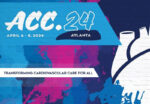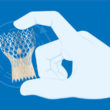Nowadays, evidence from studies and meta-analyses has demonstrated the benefits of complete revascularization compared to culprit-vessel-only revascularization in patients with acute myocardial infarction (AMI). The identification and treatment of non-culprit lesions can be guided by conventional angiography, intracoronary imaging, or coronary physiology; the optimal modality, however, is still unclear. Quantitative flow ratio (QFR) is a<a href="https://solaci.org/en/2024/05/22/functional-assessment-using-qfr-for-the-revascularization-of-non-culprit-lesions-in-ami-patients/" title="Read more" >...</a>
The best images from the SOLACI@EuroPCR 2024 joint session
Relive the best images of the SOLACI@PCR Joint Session at EuroPCR 2024, which dealt with STATE-OF-THE-ART ON LEFT MAIN INTERVENTIONS IN LATIN AMERICA and had the participation of experts from around the world.
SOLACI@PCR Joint Session at EuroPCR 2024 – See You in Paris on May 14 thru 17
The Latin American Society of Interventional Cardiology will once more say here at EuroPCR 2024, undoubtedly one of the most relevant international meetings in the field. In this context, a joint symposium will be held on Thursday 16 at 14.45 (UTC +2 – Paris time), in room 253. This session will discuss “State of the<a href="https://solaci.org/en/2024/04/25/solacipcr-joint-session-at-europcr-2024-see-you-in-paris-on-may-14-thru-17/" title="Read more" >...</a>
EXCEL Study: Complete vs. Incomplete Revascularization
Regardless of whether it is attempted through percutaneous coronary intervention (PCI) or myocardial revascularization surgery (MRS), complete revascularization (CR) is not always achieved. Overall, it is more frequent with surgery than with percutaneous treatment. Additionally, incomplete revascularization (IR) has proven to be associated with worse outcomes compared to CR. Researchers conducted an analysis of the<a href="https://solaci.org/en/2024/04/24/excel-study-complete-vs-incomplete-revascularization/" title="Read more" >...</a>
ACC 2024 | REDUCE AMI: Beta-Blockers after Myocardial Infarction and Preserved Ejection Fraction
Most clinical trials have shown benefits of beta blockers after acute myocardial infraction, including patients with extensive AMI, and these were carried out in the era before AMI was diagnosed with biomarkers and prior to treatment with coronary angioplasty, use of antithrombotic agents and high intensity statins, and angiotensin-aldosterone system inhibitors. The aim of this<a href="https://solaci.org/en/2024/04/16/acc-2024-reduce-ami-beta-blockers-after-myocardial-infarction-and-preserved-ejection-fraction/" title="Read more" >...</a>
Lithotripsy in the “Real World”: REPLICA EPIC-18 Study
Severe persistent calcification of the coronary arteries has been associated with different factors, such as advanced age, hypertension, dyslipidemia, smoking, and kidney failure, among others, and continues to be one of the challenges to stent implantation because of it impact on device advancing, drug release and adequate positioning. Intravascular lithotripsy (IVL) is a technique that<a href="https://solaci.org/en/2024/04/05/lithotripsy-in-the-real-world-replica-epic-18-study/" title="Read more" >...</a>
TAVR in the Different Types of Aortic Stenosis
Aortic stenosis (AS) is classified according to gradient into high flow and high gradient (D1), low flow-low gradient with reduced ejection fraction (D2), and paradoxical low flow-low gradient with conserved ejection fraction (D3). D3 AS is characterized by ≥50% ejection fraction, but with systolic volume index ≤35 ml/min. Post TAVR evolution of D2 and D3<a href="https://solaci.org/en/2024/04/05/tavr-in-the-different-types-of-aortic-stenosis/" title="Read more" >...</a>
AGENT-IDE: Drug Coated Balloons for Instent Restenosis
Drug eluting stents (DES) have improved considerably over the years, reducing the initial indices of instent restenosis (ISR) by roughly 5-10% a year in USA. However, DES failure might lead to neointimal hyperplasia and neoatherosclerosis, which increases the chance of developing chronic and acute coronary syndromes. Drug coated balloons (DCB), which administer anti-proliferative agents with<a href="https://solaci.org/en/2024/03/21/agent-ide-drug-coated-balloons-for-instent-restenosis/" title="Read more" >...</a>
TENDER Study, Evolution at One Year
The use of transcatheter mitral valve intervention for the treatment of mitral valve regurgitation (MR) continues to evolve; at present guidelines only recommend it for inoperable or high surgical risk patients. So far, many devices have been assessed, some of which have shown promising results, but only for poor surgical candidates. Researchers looked into the<a href="https://solaci.org/en/2024/03/15/tender-study-evolution-at-one-year/" title="Read more" >...</a>
Use of IVL in Calcified Coronary Lesions in a Real World Population
The presence of calcification in coronary arteries (CAC) remains a challenge for the percutaneous treatment of these lesions. Several studies have established the link between CAC and poor long term results. Intravascular lithotripsy (IVL) has surged as a tool to induce calcified plaque fracture. Even though studies on this strategy are not randomized, they have<a href="https://solaci.org/en/2024/03/13/use-of-ivl-in-calcified-coronary-lesions-in-a-real-world-population/" title="Read more" >...</a>









